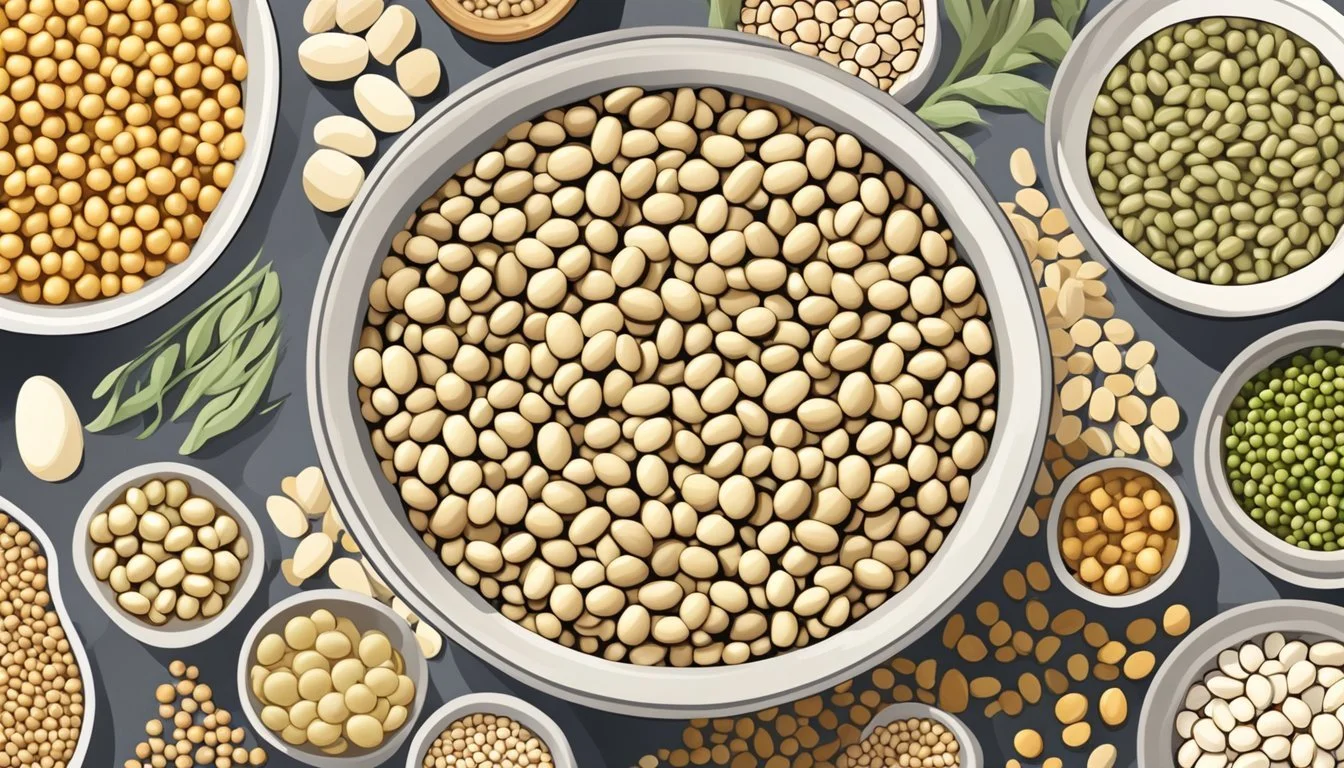Ivory Lentils Substitutes
Best Alternatives for Your Recipes
Ivory lentils, also known as white lentils, are a versatile and nutritious legume cherished by many for their delicate flavor and texture. They are particularly favored in vegetarian, vegan, and gluten-free dishes for their high protein content and ability to blend well with various ingredients. When you find yourself without ivory lentils, several substitutes can offer a similar nutritional profile and culinary versatility.
Among the best substitutes, chickpeas and cannellini beans stand out for their creamy texture and mild flavors. Chickpeas, also known as garbanzo beans, are a protein-rich option that can easily replace ivory lentils in soups, salads, and stews. Cannellini beans, with their soft texture and subtle taste, are another excellent alternative, especially in dishes that need a legume that holds its shape well.
Other viable substitutes include tofu and quinoa. Tofu, made from soybeans, offers a high protein count and a unique texture that can complement many vegetarian and vegan recipes. Quinoa, a gluten-free grain, adds a nutty flavor and additional protein, making it a fantastic ingredient to use when ivory lentils are unavailable. These alternatives ensure that your meals remain nutritious and flavorful.
Understanding Lentils
Lentils, a staple in many cuisines around the world, are nutrient-dense legumes that come in various colors and flavors. They are rich in protein, fiber, vitamins, and minerals, making them a versatile ingredient in numerous culinary applications.
Types and Colors
There are several varieties of lentils, each with unique characteristics:
Red Lentils: Quick-cooking and often used in soups and stews due to their tendency to break down.
Brown Lentils: Hold their shape well and are great for salads and side dishes.
Green Lentils: Firm texture and a peppery flavor, suitable for warm salads and stews.
Black Lentils (Beluga Lentils): Small and firm, ideal for gourmet dishes and salads.
Yellow Lentils: Common in Indian cuisine, excellent for curries and dals.
Nutritional Profile
Lentils are known for their high nutritional content. Here are their key nutrients:
Protein: Essential for muscle repair and growth, lentils are an excellent plant-based protein source.
Fiber: Aids in digestion and helps maintain healthy cholesterol levels.
Vitamins: Lentils contain significant amounts of vitamin B6, folate, and thiamine.
Minerals: A good source of iron, magnesium, and potassium, contributing to various bodily functions.
Low in Fat: They are low in fat, making them a healthy addition to any diet.
Culinary Applications
Lentils are incredibly versatile in the kitchen:
Soups and Stews: Red and yellow lentils are commonly used due to their soft texture when cooked.
Salads: Brown and green lentils hold their shape and add a hearty element.
Side Dishes: Beluga lentils are perfect for a visually appealing and nutritious side.
Curries: Yellow and red lentils absorb flavors well, making them ideal for rich, spiced dishes.
Mediterranean Cuisine: Lentils are often found in Greek and Middle Eastern dishes, adding texture and protein.
Incorporating lentils into a diet can enhance both the nutritional value and flavor of meals across various cuisines.
Ideal Substitutes for Ivory Lentils
When ivory lentils are not available, there are several suitable substitutes that can provide similar protein content, texture, and cooking versatility. These alternatives can complement diverse dishes while ensuring a nutritious and flavorful meal.
Beans and Peas
Chickpeas (Garbanzo Beans)
Chickpeas are a robust substitute for ivory lentils. They offer a slightly nutty flavor and hold their shape well during cooking. They are rich in protein and fiber, making them a nutritious choice. Chickpeas can be used in soups, stews, and salads, providing a creamy texture and hearty consistency.
Pinto Beans
Pinto beans are another excellent option, boasting a mild, slightly sweet flavor. Like ivory lentils, they are high in protein and fiber. These beans work well in dishes needing a creamy and soft texture, such as soups and casseroles. Pinto beans are also versatile in both vegetarian and meat-based recipes.
Green Peas and Split Peas
Green peas and split peas offer a sweet and earthy taste, similar to lentils. They are legumes that provide substantial amounts of protein and fiber. Green peas are ideal for adding a burst of flavor to salads and stir-fries, while split peas are excellent for creating thick, hearty soups.
Unique Legume Options
Black-Eyed Peas
Black-eyed peas, with their distinctive appearance and flavor, can be a flavorful substitute. They have a creamy texture and are high in protein and fiber. These peas hold their shape well and are suitable for stews, soups, and side dishes.
Edamame and Soybeans
Edamame (young soybeans) and mature soybeans are fantastic ivory lentil substitutes due to their high protein content and delicate flavor. Edamame can be added to salads and stir-fries, while soybeans are suitable for stews and soups. Both options provide a significant nutritional boost.
Adzuki Beans
Adzuki beans, known for their sweet taste, are good for creating dishes with a unique flair. They are high in protein and fiber and maintain their shape well when cooked. Use adzuki beans in desserts, salads, and savory dishes for a varied culinary experience.
Grains as Alternatives
Quinoa
Quinoa is a grain that serves as a superb substitute for ivory lentils, especially for those seeking a gluten-free option. It cooks quickly, has a fluffy texture, and is considered a complete protein. Quinoa can be used in salads, bowls, and as a side dish, providing a nutritious and versatile alternative.
Barley
Barley is a great choice due to its chewy texture and nutty flavor. It is high in fiber and essential nutrients, making it a nutritious substitute. Barley works wonderfully in soups, stews, and salads, providing a hearty addition to various meals.
By considering these substitutes, you can ensure that your dishes remain delicious, nutritious, and satisfying, even without ivory lentils.
Additional Substitute Considerations
When selecting an alternative for ivory lentils, it's crucial to assess the flavor profiles, texture and firmness, cooking applications, and health benefits of the chosen substitutes.
Flavor Profiles
Different substitutes bring unique flavor profiles to recipes. Chickpeas offer a slightly nutty taste that works well in various dishes. Cannellini beans provide a mild and creamy flavor, making them an excellent choice for soups and stews. Pinto beans deliver a mild, slightly sweet taste, fitting well in many culinary contexts. Each substitute impacts the overall flavor, so it’s vital to choose based on the desired outcome of the dish.
Texture and Firmness
The texture and firmness of substitutes also play a significant role. Chickpeas retain a firmness that holds up well in salads and stews. Cannellini beans offer a creamy texture that enhances the mouthfeel of soups and dips. Pinto beans have a slightly tender texture, making them versatile for various cooking methods. The adaptability of these textures ensures they can fill the gap left by ivory lentils in most recipes.
Cooking Applications
Cooking applications vary among substitutes. Chickpeas are versatile and can be used boiled, steamed, or roasted. Cannellini beans, with their creamy texture, are perfect for stews and soups. Pinto beans can be easily baked, enhancing their slightly sweet flavor. This adaptability across different cooking methods ensures that substitutions can be seamlessly integrated into various cuisines and dishes.
Health Benefits of Alternatives
Substitutes like chickpeas, cannellini beans, and pinto beans offer various health benefits. Chickpeas are high in fiber and protein, supporting digestive health and satiety. Cannellini beans provide a rich source of potassium and complex carbohydrates, aiding heart health and energy levels. Pinto beans also deliver significant amounts of fiber and numerous vitamins and minerals. These health benefits make them viable options for vegetarian and vegan diets, ensuring nutritional needs are met without sacrificing flavor or texture.
Recipes and Preparations
Ivory lentils offer a unique flavor and texture, making them a versatile ingredient in various dishes. Below, we delve into how to use ivory lentils in classic dishes and tips for substituting them with alternatives, ensuring delicious and practical meal prep.
Classic Dishes
Ivory lentils shine in numerous classic recipes due to their mild taste and smooth texture. Salads benefit greatly from their inclusion; they absorb dressings well and add a slight nuttiness. Side dishes, such as a simple lentil pilaf, highlight their ability to blend seamlessly with various spices and herbs.
The traditional lentil chili is another crowd-pleaser. Here, ivory lentils meld beautifully with rich tomato sauces and robust seasonings, creating a comforting and hearty dish. Both hummus and falafel can also utilize ivory lentils, resulting in a creamier texture and more delicate flavor compared to the usual chickpea versions.
Substitute Cooking Techniques
When ivory lentils are unavailable, various substitutes can step in effectively. Chickpeas and quinoa are top replacements; both readily absorb flavors and offer a similar protein content. In a salad, green peas can substitute for a slightly crunchy texture and a hint of sweetness.
To match the creaminess in dips like hummus, tofu serves as an excellent alternative; it blends smoothly and has a neutral taste that can be adjusted with spices. When preparing a recipe with a short cooking time, such as a quick stew or a stir-fry, canned beans can be a practical replacement, cutting down on prep time without sacrificing nutritional value.
Understanding the distinctive properties of each substitute allows for creative and successful adjustments in cooking techniques, ensuring that the intended flavor, texture, and culinary uses are retained in every dish.
Global Influences on Substitute Use
Several global cuisines have influenced the use of substitutes for ivory lentils, particularly highlighting ingredients from Middle Eastern and Indian/Mediterranean culinary traditions.
Middle Eastern Contributions
The Middle East has a rich tradition of legume-based dishes that serve as effective substitutes for ivory lentils. Chickpeas and fava beans are commonly used in staples like hummus and falafel.
Chickpeas have a nutty flavor and a creamy texture that can easily replace lentils in many recipes.
Fava beans provide a robust, earthy taste, making them ideal for hearty soups and stews. Middle Eastern cuisine often emphasizes vegetarian and vegan dishes, making legume substitutes a critical component.
Indian and Mediterranean Inspirations
Indian and Mediterranean cuisines also frequently turn to legumes as lentil substitutes. In Indian cuisine, chickpeas and pigeon peas (toor dal) are popular. These legumes are central to dishes like curries and dal, offering similar nutritional benefits and textures.
Mediterranean dishes often use white beans and black-eyed peas. For example, white beans can be found in soups and salads, delivering a mild flavor that complements a variety of spices and herbs.
These global influences highlight how versatile legume substitutes can be in diverse culinary applications, ensuring that meals remain flavorful and nutritious.






